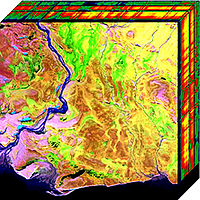
Photo from wikipedia
Localisation of metabolites in sorghum coleoptiles using Raman hyperspectral imaging analysis was compared in wild type plants and mutants that lack cyanogenic glucosides. This novel method allows high spatial resolution… Click to show full abstract
Localisation of metabolites in sorghum coleoptiles using Raman hyperspectral imaging analysis was compared in wild type plants and mutants that lack cyanogenic glucosides. This novel method allows high spatial resolution in situ localization by detecting functional groups associated with cyanogenic glucosides using vibrational spectroscopy. Raman hyperspectral imaging revealed that dhurrin was found mainly surrounding epidermal, cortical and vascular tissue, with the greatest amount in cortical tissue. Numerous “hotspots” demonstrated dhurrin to be located within both cell walls and cytoplasm adpressed towards the plasmamembrane and not in the vacuole as previously reported. The high concentration of dhurrin in the outer cortical and epidermal cell layers is consistent with its role in defence against herbivory. This demonstrates the ability of Raman hyperspectral imaging to locate cyanogenic glucosides in intact tissues, avoiding possible perturbations and imprecision that may accompany methods that rely on bulk tissue extraction methods, such as protoplast isolation.
Journal Title: Scientific Reports
Year Published: 2018
Link to full text (if available)
Share on Social Media: Sign Up to like & get
recommendations!